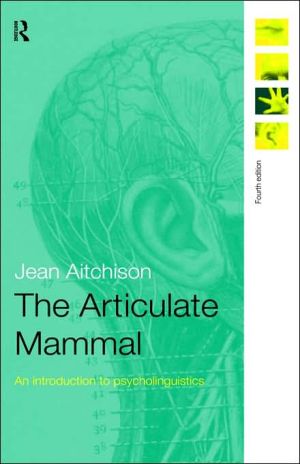

 |

|

The average rating for Articulate Mammal: An Introduction to Psycholinguistics based on 2 reviews is 4.5 stars.
Review # 1 was written on 2011-04-02 00:00:00 Jaap Bartelds Jaap BarteldsThis is a really good introduction to psycholinguistics--language acquisition, speech production, comprehension. It provides a short guide to the evolution of Chomsky's theories as well as those that run alongside and counter to his theories. There is a substantial and useful "further reading" section at the back of the book and an equally useful list of sources. I bought the Kindle version because it was more in line with my bank account than the print book, and its index is conveniently linked to indexed topics as they appear throughout the book. To top it off, the information in the book is presented clearly and is easy to follow, easy to become engaged with. |
Review # 2 was written on 2019-07-13 00:00:00 Oliver Hearsey Oliver Hearseythis books is a great introduction to the psychology of language. the age-old nurture versus nature controversy is outlined. Is language a skill which humans learn, such as knitting? Or is it natural phenomenon, such as walking or sexual activity? Skinner's (1957) attempt to explain language as similar to the bar-pressing antics of rats was a dismal failure, as Chomsky showed. Chomsky proposed instead that the human species is preprogrammed for language. human language and animal communication are compared. Some features of human language were found to be shared with some animal communication systems, but no animal system possessed them all. Attempts to teach sign and symbol systems to non-human apes are described: after a lot of effort, these apes could cope with some of the rudimentary characteristics of human language, but their achievements were far inferior to those of human children. Above all, intention reading and pattern finding seemed to be beyond the ability range of non-humans. the hard biological evidence was discussed: the human brain, teeth, tongue and vocal cords have been adapted to the needs of speech. In addition, talking requires the synchronization of so many different operations, humans seem to be 'set' to cope with this task. children's early speech is looked at. Their output is not just a random amalgam of badly copied adult utterances. Instead, they are instinctively aware that language is 'rule-governed', in that it follows consistent patterns. However, in the early stages, the rules are not necessarily linguistic ones: children might just be applying their general intelligence. three different views on child language were considered. First, Chomsky's proposal that children contain specific linguistic information which requires minimal exposure to activate was not borne out by the evidence. Second, the claim that children solve the puzzle of language by using their general intelligence, aided by helpful parents and a desire to satisfy their everyday needs, was not supported either: several individuals had been found who displayed a huge discrepancy between their linguistic and general cognitive abilities. Third, the suggestion that children make use of an inbuilt linguistic puzzle-solving device seemed nearest the truth, though the interaction between inherited principles, caretaker input, and changing mental organization is still unclear. Language cannot be explained simply as an offshoot of general intelligence, even though humans obviously use general cognitive abilities when they speak. Equally, infants do not have fixed chunks of pre-information about language. Instead, they are naturally geared to processing linguistic data. At each stage, children can handle only a certain amount: their mind is a natural filter, like a fishing net with a particular size mesh, which catches some fish, but lets others slip away. A child's mind therefore never gets overloaded. Once a certain amount of language is in place, this forms the basis for another trawl with another net, probably one with a slightly different-sized mesh. And so on and so on. Children move forward partly because each stage reached forms the basis for tackling the next. This general process is known as epigenesis. Psychologists and linguists need to combine in order to tease out the details of the epigenetic sequence associated with language. |
CAN'T FIND WHAT YOU'RE LOOKING FOR? CLICK HERE!!!